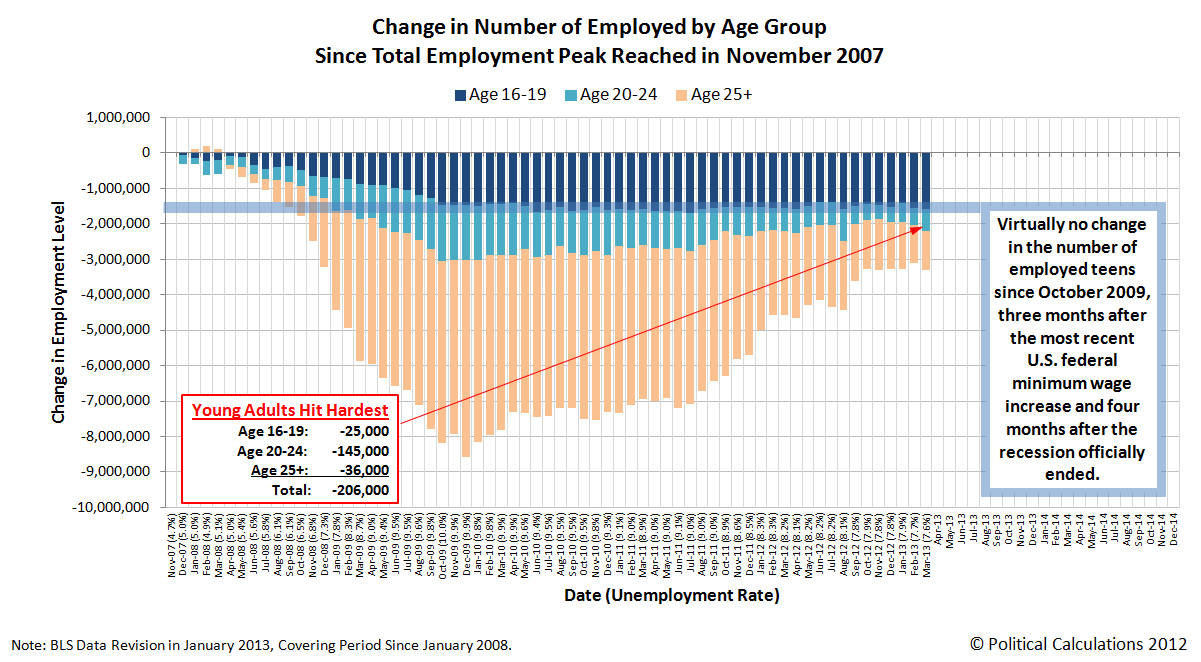In March 2013, the number of Americans counted as being employed fell by 206,000 to 143,286,000 from its level in the previous month, wiping out all of the apparent gains that had been made in that statistic since November 2012 in the process.
Working young adults between the ages of 20 and 24 were the hardest hit during the month, as their numbers in the U.S. workforce dropped sharply by 145,000 from the 13,527,000 that had been recorded as having jobs in February 2013 to the 13,382,000 counted as employed in March 2013. These individuals represent 9.3% of all employed Americans.

Click here to view a larger version of the chart.
The situation wasn't much better for other age groups, who also saw their numbers among the employed decline in the month of March 2013. The number of working adults (Age 25 and older) fell by 36,000 to 125,553,000 and the number of working teens (Age 16 to 19) was reduced by 25,000 to 4,351,000.
For all practical purposes, there has been no economic recovery for U.S. teens at all since the so-called "Great Recession" officially ended in June 2009. As a percentage of the working portion of the U.S. civilian labor force, teens now account for 3.037% of all employed Americans, the lowest share recorded for teens since July 2011, which at 3.031%, marked the lowest point for this statistic in the wake of the Great Recession.
Measured from the peak of total employment in November 2007, one month before the peak of economic expansion marking the official starting date of the Great Recession in December 2007, there are 3,309,000 fewer Americans with jobs today. Of those, 47.6% are teens (Age 16-19), 18.7% are young adults (Age 20-24) and the remaining 33.7% are Age 25 or older.
Since much has been made of the changes in the size of the civilian labor force during the past several years, we thought we might compare the data for March 2013 with November 2007. Here, in November 2007, 153,835,000 Americans Age 16 or older made up the civilian labor force, which has increased by 1,193,000 to 155,028,000 in March 2013 - an increase of 0.8%.
Of that total, the number of adults Age 25+ has increased by 1.8% over that time, from 131,502,000 in November 2007 to 133,860,000 in March 2013. Meanwhile, the number of young adults in the civilian labor force increased by 1.1%, from 15,262,000 to 15,431,000 over that interval.
The number of teens counted as being part of the civilian labor force though has declined by 18.9%, from 7,071,000 in November 2007 to 5,737,000 in March 2013. Meanwhile, the population of U.S. teens has been essentially flat over this whole time, falling slightly by 1.2% from 17,048,000 in November 2007 to 16,840,000 in March 2013.
Apparently, teens are getting a very clear message that they shouldn't even bother looking for even minimum wage jobs unless they get a college degree first.
That would mean then that help wanted ads requiring applicants to have bachelor degrees to be considered for cashier positions at places like McDonalds might not be as accidental as claimed, and might instead be a taste of things to come. Especially if the minimum wage is increased to the point where it no longer makes sense to even consider hiring someone without a college degree, or even anyone, for such increasingly automated jobs.
Labels: jobs
Welcome to the blogosphere's toolchest! Here, unlike other blogs dedicated to analyzing current events, we create easy-to-use, simple tools to do the math related to them so you can get in on the action too! If you would like to learn more about these tools, or if you would like to contribute ideas to develop for this blog, please e-mail us at:
ironman at politicalcalculations
Thanks in advance!
Closing values for previous trading day.
This site is primarily powered by:
CSS Validation
RSS Site Feed
JavaScript
The tools on this site are built using JavaScript. If you would like to learn more, one of the best free resources on the web is available at W3Schools.com.